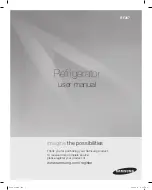
12
5. Troubleshooting
If you experience a problem with your bar fridge, check in the following table for solutions
to help you solve the problem. If after these checks you still have a problem with your
fridge, contact our after sales support line for advice.
CAUTION:
Before troubleshooting, disconnect the power supply. Any troubleshooting
that is not mentioned in this manual may only be carried out by a qualified electrician or
similarly qualified person.
Problem
Possible cause
The fridge does not work.
• It is not plugged in.
• The circuit breaker tripped or a blown fuse.
• The thermostat knob is set to the minimum position.
The compressor turns on
and off frequently. Does that
indicate that there is
a problem?
• The room temperature is hotter than normal.
• A large amount of food has been added to the fridge.
• The door is being opened too often.
• The door is not closed completely.
• The temperature control is not set correctly.
• The door gasket does not seal properly.
• The fridge does not have the correct clearances.
Note: It is normal for the compressor to switch
on/off periodically this indicates that the set
temperature is being regulated.
The temperature inside the
fridge is too warm.
• The temperature control is set too warm. Turn the
control to a cooler setting and allow several hours
for the temperature to stabilize.
• The door is kept open too long or is opened too
frequently. Warm air enters the fridge every time
the door is opened.
• The door is not closed completely.
• A large amount of warm or hot food might have
been stored recently. Wait until the fridge has had
a chance to reach its selected temperature.
• The fridge has recently been disconnected for a
period of time. At least 2 hours are required for the
fridge to cool down with the thermostat set to the
highest position.
The fridge seems to make
too much noise.
•
The rattling noise may come from the flow of the
refrigerant, which is normal.
•
As each cycle ends, you may hear gurgling
sounds caused by the flow of refrigerant.
• Contraction and expansion of the inside walls may
cause popping and crackling noises.


































